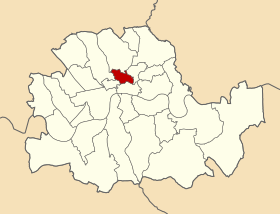Metropolitan Borough of Finsbury
| Finsbury | |
|---|---|
 Finsbury Town Hall |
|
 Finsbury within the County of London |
|
| Area | |
| • 1911/1931 | 587 acres (2.38 km2) |
| • 1931 | 586 acres (2.37 km2) |
| Population | |
| • 1911 | 87,923 |
| • 1931 | 69,888 |
| • 1931 | 32,887 |
| Density | |
| • 1911 | 150/acre |
| • 1931 | 119/acre |
| • 1931 | 56/acre |
| History | |
| • Created | 1900 |
| • Abolished | 1965 |
| • Succeeded by | London Borough of Islington |
| Status |
Metropolitan borough (1900—1965) Civil parish (1915—1965) |
| Government | Finsbury Borough Council |
| • HQ | Rosebery Avenue |
| • Motto | Altiora Petimus (We seek higher things) |
 Coat of arms granted in 1931 |
|
 Device adopted in 1900 |
|
| Subdivisions | |
| • Type | Civil parish |
| • Units |
Charterhouse (2) Clerkenwell Glasshouse Yard (3) St Luke's St Sepulchre (1) |
 Civil parishes in 1911 |
|
The Metropolitan Borough of Finsbury was a Metropolitan borough within the County of London from 1900 to 1965, when it was amalgamated with the Metropolitan Borough of Islington to form the London Borough of Islington.
The borough was formed from five civil parishes and extra-parochial places: Charterhouse, Liberty of Glasshouse Yard, St James & St John Clerkenwell, St Luke Middlesex and St Sepulchre Middlesex. In 1915 these five were combined into a single civil parish called Finsbury, which was conterminous with the metropolitan borough.
Previous to the borough's formation it had been administered by three separate local bodies: Holborn District Board of Works, Clerkenwell Vestry and St Luke's Vestry. Charterhouse had not been under the control of any local authority prior to 1900.
The borough covered the areas of Finsbury, Moorfields, Clerkenwell, and St Luke's. It bordered Islington, Shoreditch, the City of London, Holborn and St Pancras.
The metropolitan borough was administered from the town hall on Rosebery Avenue. The building was built as the headquarters of Clerkenwell Vestry, and had been officially opened on 14 June 1895 by Lord Rosebery, the Prime Minister. The architect was C Evans Vaughan, and it was described by Nikolaus Pevsner as a "nice irregular brick building with Tudor windows and lantern".
...
Wikipedia
